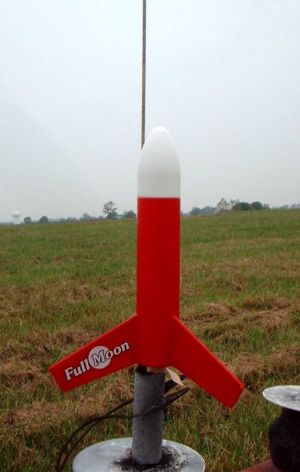| Construction Rating: | starstarstarstarstar |
| Flight Rating: | starstarstarstarstar_border |
| Overall Rating: | starstarstarstarstar_border |
| Manufacturer: | Quest  |
Brief:
A miniaturized version of the Big Betty, this little guy is a quick, easy build and reliable flyer.
Construction:
The parts list includes:
- Plastic nose cone
- BT-60 (equiv.) body tube
- 3 Laser-cut balsa fins
- Centering rings
- 18mm motor tube
- Metal motor hook
- Thrust ring
- 14" plastic chute
- Kevlar®/elastic shock cords
- 1/8" launch lug
- Peel n stick decal
This was accurately described as a skill level 1 kit, so the construction is fairly simple and straightforward. The instructions are about 3 pages and clearly written and illustrated.
The motor mount assembly is the typical 18mm tube, thrust ring, and motor hook. It also uses a couple of centering rings to slip into the BT-60 body tube. Given the large body tube, there are obvious possibilities to upscale this to 24mm, and I'm sure a few fliers have already done this.
The Kevlar and elastic shock cord combo is anchored to the motor mount. This is a great feature for a mass market kit, both rugged and durable.
The body tube needs to be marked using a wraparound guide for the standard 3-fin and lug arrangement. It's a good idea to scuff the body tube first with 120 grit sandpaper to provide a better bonding surface for the fins. Once the fins are tacked on, the rather long launch lug is glued on, essentially completing the rocket construction.
Finishing:
The standard color scheme on this is a simple paint job and is decent looking. The fins and body are a gloss red, and the nose cone is a gloss white. This doesn't even require masking, assuming you hold off on attaching the nose cone until after it's painted.
I started off with a couple coats of white primer, then followed up with Krylon red and white. After allowing a day to dry, I then applied the peel-n-stick "Full Moon" decal, which provides a nice break to the monochromatic red.
Construction Rating: 5 out of 5
Flight:
The recommended motors for this are the common mid-delay A through C motors. (Quest motors would be A6-4, B6-4, and C6-5. Estes motors would go with A8-3 instead of A6-4).
For the maiden flight, I started low since it would be flying in 10 mph conditions and loaded an A8-3 in it. It flew perfectly straight without any weathercock, but it did drift downwind a bit on the way up. Apogee was right on top.
Recovery:
The 14" chute uses shroud lines attached to holes reinforced with paper rings. This is a pretty flimsy approach and I broke loose one shroud line as a result. I would prefer tape disk retention instead, which is less likely to tear through the chute.
The chute did slow it down enough and recovery was fine.
Flight Rating: 4 out of 5
Summary:
PROs: simple build, versatile motor range, and flies well.
CONs: flimsy shroud line attachment.
This is a nice little kit, worth picking up, especially if you can grab one at one of those half-off sales.
Overall Rating: 4 out of 5
Other Reviews
- Quest Full Moon By Bill Eichelberger (April 5, 2015)
Picked up as an afterthought back in the days when Quest products were still available in local retail outlets, the Full Moon languished in my kit storage cabinet for several years before catching my eye one cold winter night when I was in the mood to build something quick. The Full Moon seems to me to be the Quest version of the Baby Bertha, a kit that I've got a long and loving ...
- Quest Full Moon By Stan Horowitz
This is a fine sport flier! It has a nice size body tube that lets you load up the parachute with ease! Every thing in the kit was in good condition in the package. The die-cut balsa fins are of good quality and a fine grain. The plastic nose cone is like most Quest/Estes types & takes paint well. I like the Quest way of mounting the shock cord with Kevlar string to the motor mount (better ...
- Quest Full Moon By Chan Stevens
For those that have followed the site for a while, you know that I enjoy "stubby" rockets (rockets with 10:1 length:width ration or less). I have built and flown a lot of "stubby" rockets. Here is a comparison of 2.6" versions , and 3" versions , and 4" versions . The Quest Full Moon™ is also a "stubby" rocket standing ...
 |
 |
Flights
 |
 |
G.H. (May 21, 2005)
H.A.F. (July 14, 2005)
R.F. (November 7, 2005)
D.E. (April 1, 2007)
D.C. (April 25, 2008)
J.F.B. (October 27, 2008)
G.B. (May 9, 2009)
 |
 |
K.R.E. (June 16, 2003)